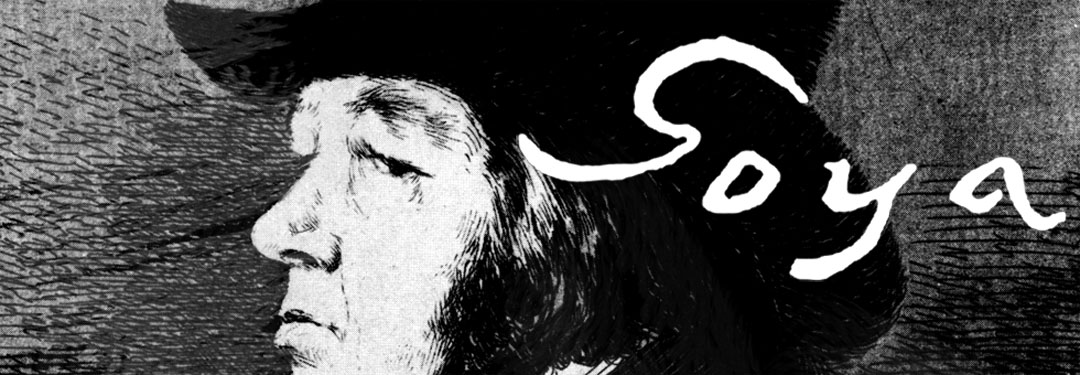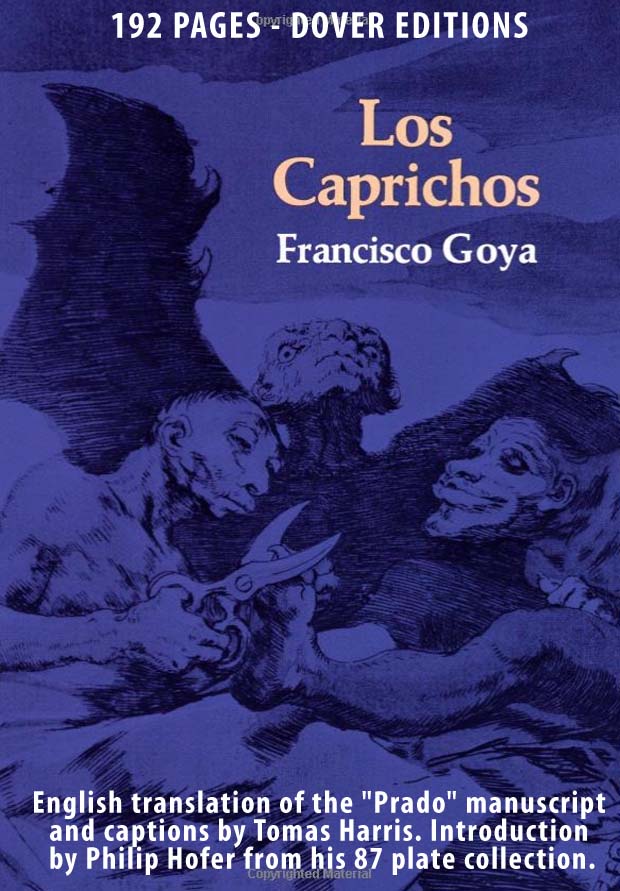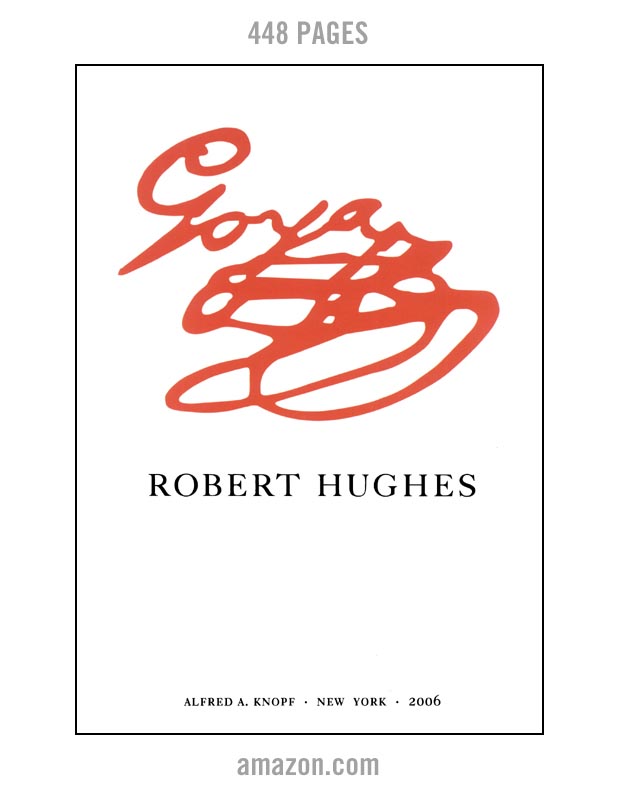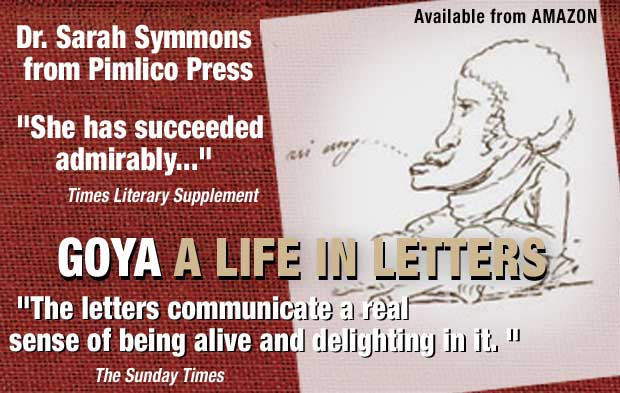Robert Hughes and Goya
Last update October 19, 2006
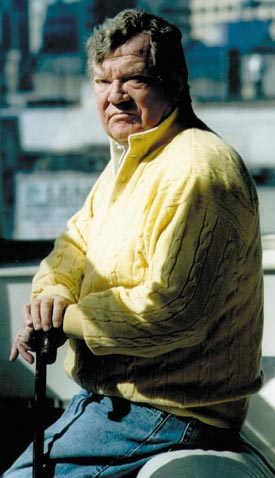
Photograph courtesy of Alfred Knopf publishers.
Credit: Joyce Ravid
Robert Hughes
Goya book released

A review specifically about this book is here.
PURCHASE AT AMAZON.COM (Softcover)
(Hughes conducted a personal promotion tour for this book, to see the schedule that was click here.)
Goya,
by Robert Hughes.
United States Edition
Hardcover, 448 pages, published by Knopf
ISBN: 0394580281
Printed in Spain
Goya,
by Robert Hughes.
Hardcover (UK Edition)
The Harvill Press; £20
Goya
Australia Edition
By Robert Hughes
Harvill, 439pp, $69.95
To read the text from the books
dustjacket flaps, go here.
Read our Goya site review on the book page here.
REVIEW BY PETER CRAVEN BOOK AT SYDNEY MORNING HERALD
"A visit from Death gave Robert Hughes the impetus to embark on his destiny: his portrait of Goya, a visionary of fear-crazed times, writes Peter Craven.
The story is told that when Robert Hughes, art critic and huntsman, lay trapped in the wreckage of his car in Western Australia, he said, in his pain and desperation, over and over: "Please God, let me live so I can write a masterpiece."
...Now we have a massive book by Hughes about Goya, and the first question it raises is whether it stands up, in terms of surging narrative and colour of orchestration, to what Hughes has already given us...
The short answer is yes. Goya presents the story of the great Spanish painter, the power and glory and black tragic ghastliness of his vision, in the context of his tumultuous, blood-drenched, fear-crazed times..." More
BOOK REVIEW AT THE DECATUR DAILY BY MARY KAY TEMPLE
"Robert Hughes' new biography of Francisco Jose de Goya y Lucientes (1746-1828) is as much about the cultural and political history of 18th-century Spain as it is about the painter and graphic artist. As Hughes reminds us, we know little about Goya's personal life, including the identity of the illness that left him completely deaf at 46, but Hughes has other reasons to avoid the traps of biographical reductionism and Freudian anachronism.
Hughes sees Goya in what the artist himself would have regarded as his most important role: as the visual chronicler of his society, the creator of its images and the interpreter of its history..." More
INTERVIEW AT THE NEW ZEALAND HERALD
"What is perhaps most impressive has been Hughes' ability, at the same time as being a full-time critic, to produce a steady stream of major books on a wide range of subjects. The Fatal Shore (1987) - a harrowing history of the origins of Australia - is his most highly acclaimed work, though its warts-and-all analysis infuriated many Australians who dubbed him "The Fatal Bore".
Of books, Hughes says: "You write a book in order to find out about a subject you don't know about. As far as I'm concerned the idea of knowing everything about a subject and then writing a book is absolute hooey."
In other words, "I'm still learning." More
INTERVIEW AT THE PALM BEACH DAILY
"Wednesday, Jan. 14, 2003 — Art critic Robert Hughes called Francisco de Goya "the first modern artist" Tuesday during his slide-illustrated talk at The Society of the Four Arts.
"Although he died 175 years ago, his work speaks to me with an urgency like no one else," he said. Goya's power has been felt by artists ranging from Phillip Guston and Pablo Picasso to filmmaker Luis Bunuel, Hughes said." More
BOOK REVIEW AT NEW ZEALAND STUFF BY BEN LOWINGS
"Throughout his powerful images there are mouths agape, howling pilgrims, muttering crowds, whispering witches; there are scenes of blood-curdling rape, knife-grinding, hammering weapons at the forge and cannonfire. They are shocking prefigurements of modernist takes on war: They have more resonance when you realise the artist was deaf". More
INTERVIEW AT THE AUSTRALIAN THE AGE
"Robert Hughes is recovering from his terrible car crash, but he remains bitter about the events that followed it. He gave this rare interview to Peter Craven.
Everyone is at least familiar with the horror story surrounding Robert Hughes, the renowned Australian art critic and TV talking head: the accident that left him crippled, the threat of extortion that came from some of the travellers in the other car, the dangerous driving charges that were laid, then dismissed, then reinstated, and his subsequent sentencing in a court this year.
Now he has written a book about Goya, the great Spanish depicter of extremity and pain, of black grotesquerie as well as the disasters of war and some sparkling society ladies.
He says he was always attracted to Goya - "I'm rather drawn to extreme situations" - but admits that the ghastliness of what he experienced fed into the book..' More here.
INTERVIEW WITH THE DENVER POST
"Q. You write that Goya can be considered as much a part of our time as (Pablo) Picasso....
A. In some ways rather more, actually. He was just about the first great realist artist. And his range of subjects included the politics of his day. It included the sexual morals. He was a tremendous portraitist of not only the rich and powerful but also the poor and not so powerful.'
Q. What is your take on the recent assertion that some of the late Goya paintings are, in fact, by his son, Javier?
A. It's rubbish. This notion was floated by a furniture historian in Madrid, Juan (José) Junquera, and then it was taken up by The New York Times, which seems to have very little judgment in these matters. There is absolutely no evidence to support this. Junquera is obliged to resort to philological quibbles.
There isn't a single Goya expert, and certainly not me, who accepts this sort of loony attempt to re-attribute the black paintings to Goya's kid. It's like saying, gee, it was actually Bacon who wrote Shakespeare's 'Hamlet.' More here.
INTERVIEW AT LA TIMES BY SUZANNE MUCHNIC
"Sometimes you are just scared of writing about the objects in your deepest affection," said Robert Hughes, reflecting on the 50-year artistic love affair that finally produced his latest book, on Spanish painter Francisco Jose de Goya y Lucientes. "I had a crisis in confidence in my abilities as a writer. I thought I probably wasn't good enough to carry this one off, to really handle him, to do justice to him. If you do a book about Goya and you screw it up, you can hear him laughing." More here.
TIMES-PICAYUNE REVIEW BY JON NEWLIN
"Goya was the finest painter of clothing who ever lived -- and what raptures and rhapsodies are inspired by Goya's satins and laces and muslins! For Hughes, they often far outdazzle any intrinsic interest the sitters might have -- 'detail for detail, no great tragic artist has ever been more absorbed, in his untragic moments, by the minutiae of fashion than Goya." More here.
ROCKY MOUNTAIN NEWS BY MARY CHANDLER
"Multiple bones shattered, Hughes finds resolution, if not rest, in his coma: "Much of the time, I dreamed about Goya. He was not the real artist, of course, but a projection of my fears. The book I meant to write on him had hit the wall; I had been blocked for years before the accident."
Many chapters later, after the introductory "Driving Into Goya," after chronological discussions of Goya's various bodies of work, after painstaking descriptions of the sad, disjointed political affairs of Spain and its royals, one thing is clear: If only Goya, that supremely talented artist and diplomat, could have visited Hughes again. Perhaps, he could have whispered some answers in Hughes' ear about the perplexing black paintings of Goya's late life, which Hughes, in more than one case, sums up as impossible to interpret." More here.
NY TIMES AUDIO INTERVIEW WITH HUGHES
Goya's "work posited a rather unstable world," says Robert Hughes in an interview about his new book about the artist. (Realaudio file, 5:39 minutes) The file is here.
NY TIMES BOOK REVIEW BY JENNY UGLOW
"Hughes places Goya's career firmly and vividly in the struggles of Spanish history and culture. Born Francisco de Goya y Lucientes, in a small village in 1746, he was the son of a master gilder, a craftsman from Zaragoza, but his mother came from the hidalgo class, the minor aristocracy whose poverty-stricken arrogance blighted rural Spain. As a young man he went to Madrid to study with his future brother-in-law, Francisco Bayeu, and after a visit to Italy in 1770 found work with Bayeu designing exuberant cartoons for the tapestries in the royal palaces of Carlos III. His themes were the popular entertainments, the street theater, musicians and fairs that he himself loved. Goya adored country life, particularly hunting, a taste he shared with the king, but he also relished the city, with its Francophile fashion victims, the petimetres and their opposites, the sexy, earthy girls known as maja, and their tough majo partners. (In one self-portrait he wears the bullfighter's short majo jacket.)" More here.
COURIER & PRESS ARTICLE BY LENNIE BENNETT
"Goya took years to complete. For many of them, Hughes felt blocked. He says he had horrific dreams in which Goya figured as his tormentor.
"It was a projection of my fears that I was not going to be able to write the book, that he was too big for me, and having him take over my dreams in that way - it didn't make the book better, but it got the book started after it had been stalled for such a long time.
"Part of me was saying, 'I'm scared of this,' the other part was saying, 'You're not going to get me down.'"
The whole article is here.
TAIWAN TAIPEI TIMES BY MICHIKO KAKUTANI
"Robert Hughes' dazzling new study of Goya not only conveys the range and prescience of the artist's work with enormous acuity and verve, but also conjures the world of 18th- and early 19th-century Spain with vivid, pictorial ardor.
Writing in fierce, tactile prose, Hughes jolts the reader into a visceral appreciation of Goya's art, while at the same time situating Goya's work against the historical backdrop of Spain's harrowing war with Napoleon and the country's sufferings under a series of ineffectual and backward rulers."
The rest of the review is here.
GLOBE AND MAIL ARTICLE BY GUY DIXON
"His work is still startling today, particularly his Disasters of War series of etchings, which depict scene after scene of brutal killing and rape, the reality of the Napoleonic wars. Their power is so immediate, that art critic and cultural writer Robert Hughes in his new book Goya argues that photography, not traditional fine art, is the true successor to Goya's visceral reportage.
"Modern art has practically nothing, or nothing of any value to say about war, because it doesn't record the horrors of it, and it just hasn't been able to deal with it," he said in an interview."
More here.
NEW YORK TIMES REVIEW BY MICHIKO KAKUTANI
"Robert Hughes's dazzling new study of Goya not only conveys the range and prescience of the artist's work with enormous acuity and verve, but also conjures the world of 18th- and early 19th-century Spain with vivid, pictorial ardor.
...he communicates the moral urgency of Goya's art and its remarkable eloquence and scope: its determination to bear witness to the great historical subjects of the day while tackling the full spectrum of folly and joy and torment that is the human condition, an audacious ambition sadly lacking in so much of contemporary art."
More of this here.
JOLLY DAYS ARTIST JOURNAL
"Goya's works are disturbing, psychologically loaded, ambiguous - far more modern in their complexity than images of our own time which seldom even attempt to explore this realm of the psychological complexities of the human condition." more here.
BOSTON GLOBE
Brief mention of Hughes & the Goya book
ARTFUL CODGER It's been a disastrous few years for the world's most famous art critic, Robert Hughes; he was nearly killed in a car accident in the Australian outback, and his only son committed suicide. But yesterday, in an uncomfortable chair at the Museum of Fine Arts, the celebrated author of "The Shock of the New" was remarkably at ease. (Hughes delivered a sold-out lecture at the MFA last night.) The curmudgeon's contentment has everything to do with "Goya," a fat book he's finally finished after years of research and writing. "It'll hit the street with a great muddy splash," Hughes said. "But look, mate, being a famous art critic is a little like being a famous beekeeper." That's not entirely true, at least in his native Australia, where Hughes is an icon, as well known as his countryman Russell Crowe. "I have vast admiration for him," Hughes said, adding that the Gladiator would make a good Goya... More at the Boston Globe website here.
AUSTRALIAN ARTICLE PRIMARILY ON HUGHES here.
FINANCIAL TIMES INTERVIEW WITH HUGHES here
NEW YORKER JOHN UPDIKE REVIEW
Among pre-modern artists whose reputations flourish in the present day, Goya is unusual in that his content matters more than his painterly technique. His cycle of etchings “Los desastres de la guerra” is still viewed as an effectively shocking depiction of war’s horrors; the etchings called “Caprichos” and the late “black” paintings done on the walls of his farmhouse outside Madrid win admiration as uncanny incursions, with their witches and murky combats, into the subconscious, anticipating Surrealism. More
UK INDEPENDENT INTERVIEW
"When Robert Hughes greets me at the door to his London hotel room, with tousled hair and weather- beaten face, leaning on the stick he has used since a near-fatal car accident in 1999, I am immediately reminded of the first Goya drawing illustrated on page 22 of his new book. The drawing was made near the end of the Spanish artist's life, and shows an old man with a flowing beard, walking with the aid of two sticks. Hughes's description sounds suspiciously like an ideal self-portrait: [Goya] "was a tough, tenacious old bird, and he had every right to make, towards the end, that inspiring drawing of an ancient, bearded man, like Father Time himself, hobbling along with the aid of two canes with the scrawled caption - 'I'm still learning'." More
ECONOMIST.COM REVIEW
"Mr Hughes loves Goya, not Goya myths. No, he tells us, the deaf painter in his 50s was not the Duchess of Alba's lover. Nor do the two famous Majas depict her—she was already mortally ill when he began them. No, he was not a radical martyr. In 1803, he sold the plates and 240 sets of the supposedly subversive “Caprichos” to the Spanish crown. An enfeebled Inquisition did use one of its last teeth to investigate him for obscenity but dropped the case as being devoid of merit. During the anti-French resistance, Goya portrayed willy-nilly Napoleon's officials, the victorious Wellington and restored Bourbons. A liberal exile in Bordeaux after 1824, he nevertheless won a pension for his long service to the Spanish court.
Mr Hughes is not out to debunk Goya but to locate his genius." More
UK GUARDIAN "PREVIEW"
"We have made him a modernist ancestor. His influence, the inspiration of his presence, the pressing need to reckon with him, lie behind a surprising number of careers: much of Manet, for instance, depends on Goya, just as much of the film imagery of Luis Buñuel does; and you can't easily imagine Picasso or Beckmann without him. The glaring electric light in Picasso's Guernica is nothing other than the cubical lantern casting its pitiless radiance on the massacre victims of Goya's Third of May . His genius for telling the truths of suffering without false heroics has made him the patron saint of every war photographer. The words he wrote on one plate of his great series of etchings, Los Desastres de la Guerra (The Disasters of War) are still the declaration of every documentarian, every realist, every artist who would be thought unflinching: Yo lo vi , "I saw it". And these are balanced by their contrary, the title of another "Disaster": No se puede mirar , "One cannot look at this".
Some aspects of Goya are remote from our ironised culture. We cannot believe art can change the moral focus of the world. Goya did, and his intense earnestness puts him at a remove from our world. He wanted to make images that compel a moral understanding of ordinary and terrible things. In this, he is unlike practically any artist now alive." More
SOME HUGHES LINKS
Salon 1997 article "The People's Critic."
New York Times Magazine "The Critic in Exile." 2001 article on Hughes near-fatal car crash in Australia: "Robert Hughes's pugnacious style made him a hero among his fellow Australians. Until the car crash, that is. Now his refusal to back down may cost him their good will - and even his freedom.".
Toronto Star 1997 Article "Aussie art bloke conquers Yanks: Meet Robert Hughes, the world's greatest art critic," By Heather Mallick
Art Newspaper.com 2001 John McDonald article: "Robert Hughes, an Australian tragedy."
"One of the world’s most famous and courageous art critics an Australian by birth and in his sentiments, has goaded his home country into rejecting him...The next stage in Hughes’s descent came with a trial in Broome in May, one year after the accident, in which he had to defend himself against two counts of dangerous driving...
In the subsequent trial, Bowe and Kelly were not called to testify, and Hughes— who had pleaded not guilty to the dangerous driving charges— was acquitted for lack of evidence. It was an extraordinarily good result, but Hughes toasted his success by holding a press conference on the steps of the courthouse, in which he referred to Bowe, Kelly and Bennett as “low-life scum”. The extortion attempt proved that they were “dumb scum”.
AMAZON
Goya The Terrible Sublime - Graphic Novel - (Spanish Edition) - Amazon
"From this headlong seizure of life we should not expect a calm and refined art, nor a reflective one. Yet Goya was more than a Nietzschean egoist riding roughshod over the world to assert his supermanhood. He was receptive to all shades of feeling, and it was his extreme sensitivity as well as his muscular temerity that actuated his assaults on the outrageous society of Spain." From Thomas Craven's essay on Goya from MEN OF ART (1931).
"...Loneliness has its limits, for Goya was not a prophet but a painter. If he had not been a painter his attitude to life would have found expression only in preaching or suicide." From Andre Malroux's essay in SATURN: AN ESSAY ON GOYA (1957).
"Goya is always a great artist, often a frightening one...light and shade play upon atrocious horrors." From Charles Baudelaire's essay on Goya from CURIOSITES ESTRANGERS (1842).
"[An] extraordinary mingling of hatred and compassion, despair and sardonic humour, realism and fantasy." From the foreword by Aldous Huxley to THE COMPLETE ETCHINGS OF GOYA (1962).
"His analysis in paint, chalk and ink of mass disaster and human frailty pointed to someone obsessed with the chaos of existence..." From the book on Goya by Sarah Symmons (1998).
"I cannot forgive you for admiring Goya...I find nothing in the least pleasing about his paintings or his etchings..." From a letter to (spanish) Duchess Colonna from the French writer Prosper Merimee (1869).
GOYA : Los Caprichos - Dover Edition - Amazon
